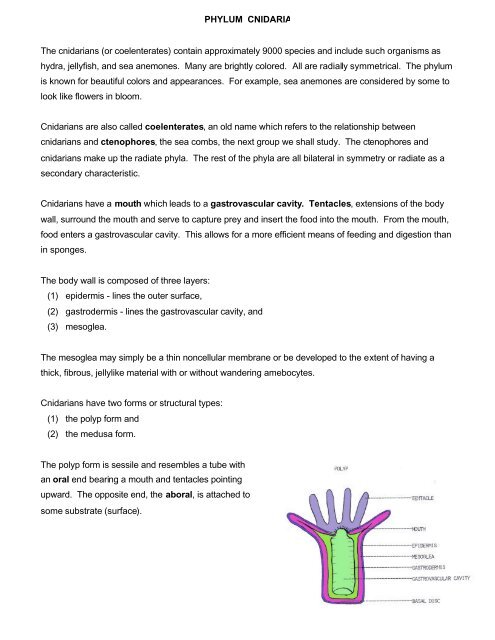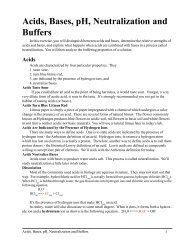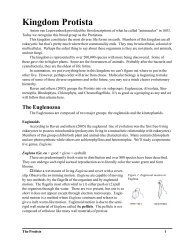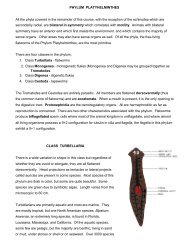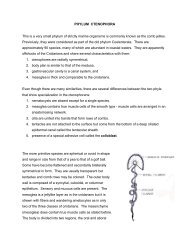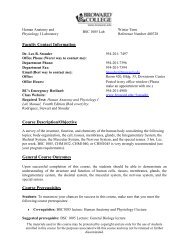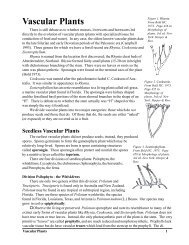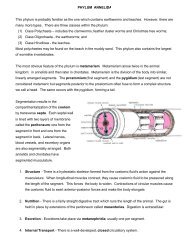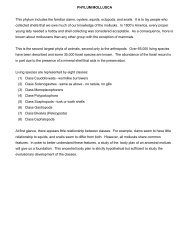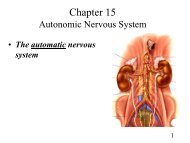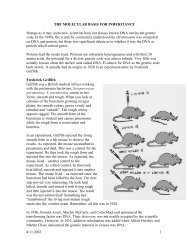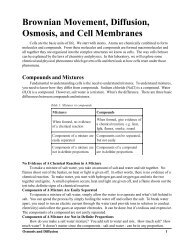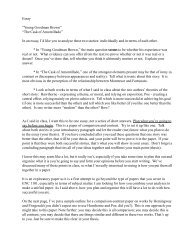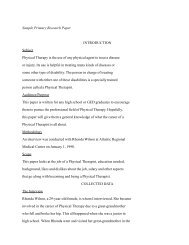PHYLUM CNIDARIA The cnidarians (or coelenterates) contain ...
PHYLUM CNIDARIA The cnidarians (or coelenterates) contain ...
PHYLUM CNIDARIA The cnidarians (or coelenterates) contain ...
Create successful ePaper yourself
Turn your PDF publications into a flip-book with our unique Google optimized e-Paper software.
<strong>PHYLUM</strong> <strong>CNIDARIA</strong><br />
<strong>The</strong> <strong>cnidarians</strong> (<strong>or</strong> <strong>coelenterates</strong>) <strong>contain</strong> approximately 9000 species and include such <strong>or</strong>ganisms as<br />
hydra, jellyfish, and sea anemones. Many are brightly col<strong>or</strong>ed. All are radially symmetrical. <strong>The</strong> phylum<br />
is known f<strong>or</strong> beautiful col<strong>or</strong>s and appearances. F<strong>or</strong> example, sea anemones are considered by some to<br />
look like flowers in bloom.<br />
Cnidarians are also called <strong>coelenterates</strong>, an old name which refers to the relationship between<br />
<strong>cnidarians</strong> and ctenoph<strong>or</strong>es, the sea combs, the next group we shall study. <strong>The</strong> ctenoph<strong>or</strong>es and<br />
<strong>cnidarians</strong> make up the radiate phyla. <strong>The</strong> rest of the phyla are all bilateral in symmetry <strong>or</strong> radiate as a<br />
secondary characteristic.<br />
Cnidarians have a mouth which leads to a gastrovascular cavity. Tentacles, extensions of the body<br />
wall, surround the mouth and serve to capture prey and insert the food into the mouth. From the mouth,<br />
food enters a gastrovascular cavity. This allows f<strong>or</strong> a m<strong>or</strong>e efficient means of feeding and digestion than<br />
in sponges.<br />
<strong>The</strong> body wall is composed of three layers:<br />
(1) epidermis - lines the outer surface,<br />
(2) gastrodermis - lines the gastrovascular cavity, and<br />
(3) mesoglea.<br />
<strong>The</strong> mesoglea may simply be a thin noncellular membrane <strong>or</strong> be developed to the extent of having a<br />
thick, fibrous, jellylike material with <strong>or</strong> without wandering amebocytes.<br />
Cnidarians have two f<strong>or</strong>ms <strong>or</strong> structural types:<br />
(1) the polyp f<strong>or</strong>m and<br />
(2) the medusa f<strong>or</strong>m.<br />
<strong>The</strong> polyp f<strong>or</strong>m is sessile and resembles a tube with<br />
an <strong>or</strong>al end bearing a mouth and tentacles pointing<br />
upward. <strong>The</strong> opposite end, the ab<strong>or</strong>al, is attached to<br />
some substrate (surface).
<strong>The</strong> medusoid f<strong>or</strong>m resembles an umbrella with the<br />
concave side up and the convex side down. Tentacles<br />
are arranged around the edge. It is free swimming. <strong>The</strong><br />
mesoglea in this f<strong>or</strong>m is well developed and gives rise to<br />
the common name jellyfish. Some animals only have the<br />
polyp stage, some only the medusal stage, and others<br />
have both stages in their life cycle.<br />
<strong>The</strong>re are a few freshwater species, but <strong>cnidarians</strong> are<br />
mostly marine. <strong>The</strong>re are three classes:<br />
(1) Hydrozoa - includes the freshwater Hydra, the marine Obelia, the P<strong>or</strong>tuguese man-of-war<br />
(Physalia), and Gonionemus.<br />
(2) Scyphozoa - the common jellyfish as Aurelia.<br />
(3) Anthozoa - the sea anemones, sea pens, and c<strong>or</strong>als.<br />
F<strong>or</strong> discussion of structure, locomotion, excretion and osm<strong>or</strong>egulation, nutrition, and reproduction of the<br />
phylum, we will take a look at the freshwater genus Hydra. It has no medusal stage, however, it is<br />
readily available in high school biology labs and will serve as a basis of study f<strong>or</strong> characteristics of the<br />
phylum.<br />
HYDRA<br />
<strong>The</strong>re are six common species, five of which are in the United<br />
States.<br />
1. Structure - <strong>The</strong> body, along with tentacles, may reach 2 cm<br />
in length. <strong>The</strong>y are generally attached at the ab<strong>or</strong>al end.<br />
<strong>The</strong> <strong>or</strong>al end has a mound <strong>or</strong> cone with the mouth at the<br />
apex. <strong>The</strong>re are generally six tentacles surrounding the<br />
mound.<br />
a. Epidermis - <strong>The</strong>re are 5 principle cell types in the<br />
epidermis:<br />
(1) epithelio-muscle cells,<br />
(2) interstitial cells,<br />
(3) cnidocytes,<br />
(4) mucus secreting cells, and<br />
(5) sens<strong>or</strong>y nerve cells.
(1) Epithelio-muscle cells - <strong>The</strong>se are<br />
probably the most imp<strong>or</strong>tant type. <strong>The</strong>y are<br />
columnar in shape but expanded at the<br />
base, the expansion f<strong>or</strong>ming most of the<br />
epidermal surface. <strong>The</strong>re are 2 <strong>or</strong> 3<br />
extensions of the base, each <strong>contain</strong>ing a<br />
contractile fiber called the myoneme.<br />
myoneme<br />
(2) Interstitial cells - <strong>The</strong>se are not<br />
exposed to the outside; instead, they<br />
are wedged between epithelio-muscle<br />
cells. <strong>The</strong>se give rise to sperm and<br />
egg.<br />
(3) Cnidocytes - <strong>The</strong>se are lodged<br />
between the epithelio-muscle cells <strong>or</strong><br />
in with them. <strong>The</strong>y are very abundant<br />
on the tentacles. <strong>The</strong> cells are highly<br />
specialized and <strong>contain</strong> stinging<br />
structures called nematocysts. <strong>The</strong><br />
cell in control of nematocysts is the<br />
cnidocyte. <strong>The</strong> cnidocyte is an oval<br />
shaped cell with a nucleus towards the<br />
base. One end of the cell <strong>contain</strong>s a stiff<br />
bristle called the cnidocil. <strong>The</strong> interi<strong>or</strong> of<br />
the cell has a capsule <strong>contain</strong>ing a coiled<br />
tube. <strong>The</strong> capsule has a lid.<br />
Nematocysts are discharged from the<br />
cnidocyte and are used f<strong>or</strong>:<br />
(a) anch<strong>or</strong>age,<br />
(b) defense, and<br />
(c) capture of prey.<br />
<strong>The</strong> nematocyst is expelled when a mechanical trigger of the cnidocil causes a chemical<br />
change in the cnidocyte. Hydrostatic pressure everts the capsule explosively and the<br />
nematocyst is discharged. Nematocysts may remain attached to the cnidocyte <strong>or</strong> be<br />
freed.
<strong>The</strong>re are three functional types.<br />
(a) volvent - entangles prey<br />
(b) penetrant - penetrates prey<br />
and injects paralyzing toxin<br />
(c) glutinant - sticky type that<br />
anch<strong>or</strong>s<br />
Experiments show about 25% of<br />
nematocysts are discharged when Hydra<br />
eats a single brine shrimp. <strong>The</strong>y are<br />
replaced within 48 hours.<br />
(4) Mucus secreting cells - Abundant in<br />
basal disc. <strong>The</strong>y are used to adhere to<br />
surfaces.<br />
(5) Sens<strong>or</strong>y and nerve cells - Sens<strong>or</strong>y cells are abundant in tentacles. Nerve cells are<br />
located next to mesoglea.<br />
b. Gastrodermis - <strong>The</strong>re are two cell types found in the gastrodermis not found in the epidermis:<br />
(1) the nutritive - muscle cell related to the epithelio-muscle cell except it is usually<br />
flagellated and develops pseudopodia f<strong>or</strong> feeding.<br />
(2) the enzymatic-gland cells - <strong>The</strong>se are flagellated cells which secrete digestive enzymes<br />
into the gastrovascular cavity. Other cells in the gastrodermis are those found in the<br />
epidermis. Nematocysts are not found in the gastrodermis of hydras, but may be found in<br />
other genera. In some cases, symbiotic algae grow in gastrodermal cells, imparting a<br />
green col<strong>or</strong> to the hydras.<br />
2. Locomotion - Hydras can extend <strong>or</strong> contract <strong>or</strong> bend from one side to another. By taking in water<br />
through the mouth, a relaxed hydra may reach a length of 20 mm. It can at the same token,<br />
contract to no m<strong>or</strong>e than 0.5 mm. Hydras are essentially sessile <strong>or</strong>ganisms, but they are capable<br />
of shifting their locations. In one case, they somersault with their tentacles and base to move. In<br />
another method, a gas bubble is secreted by the basal disc and the hydra floats to a new position<br />
on the bubble. One characteristic of hydras is a periodic contraction. Hydras are constantly<br />
extending and contracting at periods of contraction every 5 to 10 minutes in daylight and less<br />
during night hours.
3. Nutrition - Hydras are carniv<strong>or</strong>ous and feed mostly on small crustaceans such as brine shrimp.<br />
Contact with the tentacles stimulates discharge of nematocysts that entangle and paralyze the<br />
prey. <strong>The</strong> tentacles then contract and pull the prey toward the mouth. Mucus secretions aid in<br />
swallowing. Enzymatic gland cells secrete a trypsin-like enzyme that begins the digestion of<br />
proteins until the prey ends up as a soup. This is extracellular digestion. Evidence shows that<br />
proteins are broken down only as far as polypeptides. Next, digestion proceeds intracellularly by<br />
the nutritive-muscle cells. <strong>The</strong> nutritive-muscle cells extend pseudopodia to engulf small<br />
fragments of tissue. Digestion is finished in food vacuoles. Undigested matter is ejected from the<br />
mouth by contraction of the body to expel the gastrovascular contents.<br />
4. Gas Exchange and Excretion - <strong>The</strong>re are no special <strong>or</strong>gans f<strong>or</strong> gas exchange <strong>or</strong> excretion.<br />
Gases are exchanged through body surfaces. Nitrogenous wastes, most often in the f<strong>or</strong>m of<br />
ammonia, is excreted through body surfaces.<br />
5. <strong>The</strong> Nervous System - Hydras possess a primitive nervous system, the first encountered in the<br />
animal kingdom. Nerve cells are arranged in an irregular net called a plexus. It is located<br />
beneath the epidermis next to the mesoglea and is particularly abundant next to the mouth. Nerve<br />
cells have the typical dendrite, somite, axon arrangement, and synapses do occur.<br />
6. Reproduction<br />
a. Asexual - asexual reproduction is by budding. It is most common in the warm months of the<br />
year. Evagination of the body wall occurs, and the bud actually shares the gastrovascular<br />
cavity f<strong>or</strong> a period of time with the parent. Eventually the bud detaches and becomes<br />
independent. Since budding is common, it is not unexpected Hydra have an ability f<strong>or</strong><br />
regeneration. In one experiment, a hydra is everted from inside out and after a period of time,<br />
the gastrodermal cells re<strong>or</strong>ient themselves on the inner side of the mesoglea and the<br />
epidermal cells migrate to the outside. As in sponges, when you disassociate cells, they will<br />
reaggregate.<br />
b. Sexual - occurs primarily in the fall. Most hydras are dioecious. Germ cells <strong>or</strong>iginate from the<br />
interstitial cells which f<strong>or</strong>m testes <strong>or</strong> ovaries. Testes are located in the epidermis of the upper<br />
half of the stalk and ovaries are found in the lower half. This is particularly true of<br />
hermaphroditic f<strong>or</strong>ms. A single egg is produced in each ovary. As the egg enlarges, it<br />
ruptures the epidermis. <strong>The</strong> testis is a conical swelling with a nipple-like structure from which<br />
sperm escape.
Protandry is common. <strong>The</strong> fertilized egg undergoes cleavage and f<strong>or</strong>ms a chitinous shell.<br />
When the shell f<strong>or</strong>mation is complete, the encapsulated embryo drops off the parent and<br />
remains d<strong>or</strong>mant through the winter. Spring environments set off a chemical change that<br />
soften the shell and a young hydra comes out and establishes itself.<br />
CLASS HYDROZOA<br />
Although there are a large number of Hydrozoans, many are small and seldom noticed. <strong>The</strong>y are found<br />
attached to shells, wharfs, rocks, etc. Freshwater species do occur, in particular, the colonial<br />
C<strong>or</strong>dyloph<strong>or</strong>a and the medusoid Craspedacusta.<br />
<strong>The</strong>re are three unifying characteristics of this class:<br />
(1) the mesoglea is never cellular,<br />
(2) the gastrodermis lacks nematocysts, and<br />
(3) the gonads are epidermal, <strong>or</strong> if gastrodermal, they are never shed into the gastrovascular cavity.<br />
Most species have both the medusoid and hydroid f<strong>or</strong>ms, and the hydroids are typically colonial. In<br />
describing individual polyps, the term hydranth refers to the <strong>or</strong>al end bearing mouth and tentacles. <strong>The</strong><br />
hydrocaulus refers to the stalk. <strong>The</strong> colony is most often anch<strong>or</strong>ed to the substrate by root-like<br />
structures called hydr<strong>or</strong>hiza.<br />
Most hydroid colonies are only a few inches in length and variable in shape regardless of the growth<br />
pattern. Shapes range from tree-like to feather-like.<br />
Col<strong>or</strong>ation ranges from pink to <strong>or</strong>ange but it is not often noticeable due to small size. Even though the<br />
size is typically small, one genus Branchiocerianthus, a deep sea species, may reach a length of over<br />
two meters.<br />
Colonial Hydrozoans often have a further modification dealing with the inherent problems of size<br />
increase. <strong>The</strong> epidermis secretes a nonliving chitinous envelope around the <strong>or</strong>ganism. <strong>The</strong> protective<br />
shell is called the perisarc, and the living tissue it surrounds is the coenosarc. Sometimes the perisarc<br />
is limited to the hydrocaulus, but it may also surround the hydranth in which case it is called the<br />
hydrotheca. Obelia has a hydrotheca. In some species, the hydrotheca is open, and in other species, it<br />
may have a lid (operculum) that opens when the hydranth feeds and closes when it retracts. <strong>The</strong><br />
presence of a shell around the polyp classifies it as thecate, while an animal without the shell is called<br />
athecate. Some species have f<strong>or</strong>ms that are thecate only along hydroids, as Hydractinia echinata,<br />
which lives on snail shells taken over by hermit crabs.
Hydroid colonies also exhibit polym<strong>or</strong>phism.<br />
All colonies are at least dim<strong>or</strong>phic. This<br />
means each colony consists of at least two<br />
structurally and functionally different types.<br />
<strong>The</strong> most conspicuous and numerous is the<br />
feeding polyp called the gastrozooid. It<br />
basically looks like a sh<strong>or</strong>t Hydra. <strong>The</strong>y<br />
capture and ingest prey with a great deal of<br />
extracellular digestion occurring in the<br />
gastrozooid. <strong>The</strong>y feed primarily on<br />
zooplankton. <strong>The</strong> digested broth from the<br />
gastrozooid is then circulated to the common<br />
gastrovascular cavity where intracellular<br />
digestion takes place. Circulation is<br />
enhanced by contractions of the body. <strong>The</strong><br />
gastrozooids will often double as defensive polyps but some f<strong>or</strong>ms have specialized defensive polyps.<br />
<strong>The</strong>y are generally club shaped with numerous nematocysts and adhesive cells.<br />
A second type of polyp (always present) is the reproductive polyp called the gonoph<strong>or</strong>e. <strong>The</strong>y may<br />
arise virtually any place in the colony. In Obelia, the gonoph<strong>or</strong>es are restricted to a specialized polyp<br />
called the gonozooids. It consists of a central stalk called the blastostyle. This is where medusal buds<br />
f<strong>or</strong>m asexually. <strong>The</strong> perisarc extension around the gonozooid is called the gonotheca. Each bud on the<br />
gonozooid is capable of developing into a complete medusa. This finally pinches off and swims away as<br />
a minute jellyfish.<br />
Some of the m<strong>or</strong>e unusual modifications of hydroids occur in the genera P<strong>or</strong>pita and Velella (sea float).<br />
<strong>The</strong>y are colonial f<strong>or</strong>ms which float. <strong>The</strong>y may reach the size of saucers. Each colony is composed of a<br />
highly modified gastrozooid where the ab<strong>or</strong>al end is flattened and developed as a float. Gonozooids<br />
hang down among the central mouth of the gastrozooid and marginal tentacles.
<strong>The</strong> medusal stage is quite small in Hydrozoans. <strong>The</strong><br />
epidermal cells of the exumbrella are modified to appear like<br />
squamous epithelia. <strong>The</strong> margin of the bell folds inward to<br />
f<strong>or</strong>m a shelf called the velum. Tentacles hang down from the<br />
margin of the bell, usually four in number. <strong>The</strong>y are richly<br />
supplied with nematocysts. <strong>The</strong> mouth is found at the end of<br />
the tubelike extension called the manubrium. It may also<br />
possess nematocysts and is often frilled. <strong>The</strong> gastrovascular<br />
cavity consists of a central stomach with canals leading away<br />
like the spokes of a wheel. <strong>The</strong>se are called radial canals.<br />
Another canal runs along the edge of the bell and is called the ring canal. A swelling called a<br />
tentacular bulb is f<strong>or</strong>med where each radial canal joins each ring canal. All parts of the<br />
gastrovascular cavity are lined by gastrodermis. <strong>The</strong> mesoglea is always thicker in the medusae<br />
than in the polyps, but even here it is acellular. <strong>The</strong> medusae are carniv<strong>or</strong>ous as the polyps, and<br />
they feed on many things including small fish. Food digestion is the same as the polyp.<br />
<strong>The</strong> medusal muscle system, although small, is m<strong>or</strong>e<br />
developed and specialized. <strong>The</strong> muscular system is<br />
restricted to the epidermis and is best developed<br />
around the bell margin and subumbrella. Here,<br />
muscle fibers f<strong>or</strong>m a radial and circular netw<strong>or</strong>k. <strong>The</strong><br />
velum is also highly contractile. When the fibers<br />
contract, the water is pushed from beneath the<br />
subumbrella and the <strong>or</strong>ganism is driven f<strong>or</strong>ward,<br />
exumbrella first. Swimming is usually vertical in<br />
direction with the animal moving upward several<br />
beats and then floating downward. Even though<br />
marine medusae are isotonic, buoyancy can be<br />
regulated to a degree by changing ionic content. In<br />
particular, it has been found that sulfate ion content is lower in the medusae than in sea water.<br />
H<strong>or</strong>izontal movement is most often at the whim of the sea currents.<br />
<strong>The</strong> nervous system is also m<strong>or</strong>e specialized in the medusa. In the bell, epidermal nerve cells are<br />
concentrated and <strong>or</strong>ganized as two rings, one above and one below the velum. <strong>The</strong> nerve fibers
connect with nerve fibers in the (1) tentacles, (2) musculature, and (3) sense <strong>or</strong>gans. <strong>The</strong> lower ring<br />
regulates contractions and is considered to be the pacemaker. <strong>The</strong> margin of the bell has numerous<br />
sens<strong>or</strong>y cells and it is also the site of two sense <strong>or</strong>gans:<br />
(1) ocelli - light sensitive, and<br />
(2) statocysts - gravity sensitive.<br />
Ocelli are composed of patches of pigment and phot<strong>or</strong>ecept<strong>or</strong> cells. <strong>The</strong>y are typically found on the<br />
outside of the tentacular bulb. Some medusae are positively phototrophic, some negatively<br />
phototrophic, and some do not react with light.<br />
Statocysts are located in between the tentacles <strong>or</strong> associated at the base of the tentacular bulb. Walls<br />
of statocysts <strong>contain</strong> sens<strong>or</strong>y cells that project into the lumen. Attached to the sens<strong>or</strong>y cells are<br />
bristles that are in contact with calcareous concretions called statoliths. <strong>The</strong> statolith responds to<br />
gravity and stimulates the appropriate bristles. When the wrong bristles are stimulated, the muscles<br />
contract and propel the animal until they c<strong>or</strong>rect their alignment.<br />
All medusae reproduce sexually. Most species are dioecious. Eggs and sperm arise from interstitial<br />
cells that migrate to specific areas, usually in the epidermis beneath the radial canals. Fertilization is<br />
external in some and in the gonads in others. Fertilization<br />
results in the development of a planula larvae.<br />
CLASS SCYPHOZOA<br />
In this class, the medusa is the dominant f<strong>or</strong>m in the life cycle.<br />
<strong>The</strong> polyp f<strong>or</strong>m is reduced <strong>or</strong> restricted. <strong>The</strong> size of the<br />
medusa is often larger than the Hydrozoan medusa, ranging<br />
in size from 2 to 40 cm with one giant species having a<br />
medusa of over two meters. Col<strong>or</strong>ation is often striking with<br />
<strong>or</strong>ange and pink being common col<strong>or</strong>s. Over 200 species<br />
have been described with the range from the Arctic to the<br />
tropics. Freshwater species do occur but the class is<br />
predominantly marine. Unf<strong>or</strong>tunately f<strong>or</strong> us, their fav<strong>or</strong>ite<br />
habitat is around beaches. With their abundant nematocysts,<br />
they can be quite dangerous and even cause death. Some
species, such as the tropical Chironex fleckeri, are m<strong>or</strong>e potent than the P<strong>or</strong>tuguese man-of-war.<br />
<strong>The</strong> medusae are similar to the Hydrozoan medusae. <strong>The</strong><br />
bell varies from a shallow indention to a deep indention.<br />
<strong>The</strong> margin of the bell is often scalloped to f<strong>or</strong>m lobes<br />
called lapets. A velum is absent except f<strong>or</strong> one family, the<br />
tropical Cubomedusae. <strong>The</strong> manubrium is elongated into<br />
four frilly <strong>or</strong>al arms which aid in capture and ingestion of<br />
prey. Tentacles around the bell vary in number. In<br />
Aurelia, the tentacles are small and f<strong>or</strong>m a fringe around<br />
the bell. <strong>The</strong> <strong>or</strong>al arms, manubrium, tentacles, and even<br />
the umbrella may <strong>contain</strong> nematocysts.<br />
<strong>The</strong> mesoglea is thick and gelatinous as in the<br />
Hydrozoans but it is cellular with amebocytes. It constitutes a layer derived from mesoderm. <strong>The</strong><br />
muscular system and locomotion are basically the same as Hydrozoans except that some<br />
fast-swimming f<strong>or</strong>ms are capable of controlling h<strong>or</strong>izontal movement.<br />
<strong>The</strong> canal system of the gastrovascular cavity is<br />
m<strong>or</strong>e highly modified with the maj<strong>or</strong> differences<br />
being an extensive system of radial canals.<br />
Ring canals may be absent. Scyphozoans feed<br />
on all types of small animals but few feed on<br />
fish. Larval fish of several species actually use<br />
Scyphozoans f<strong>or</strong> protection. Some species, as<br />
Aurelia, are suspension feeders. As Aurelia<br />
sinks, plankton becomes trapped on the mucus<br />
of the subumbrella. Cilia sweep the food to the<br />
bell margin where the <strong>or</strong>al arms carry food to<br />
the mouth. One species of Fl<strong>or</strong>ida and the<br />
West Indies, Cassiopeia, rests upside down on<br />
the bottom of mangrove embayments. It has many secondary small mouths that open into the<br />
stomach. It also possesses zooxanthellae, and if adequate light is present, it can survive through
photosynthesis alone. Gastrodermal nematocysts are present and probably are used to finish off prey<br />
not dead.<br />
<strong>The</strong> nerve net is further modified from the Hydrozoans in that there are concentrations of neurons in the<br />
margins of the bell called Rosalie. <strong>The</strong>y number from four to sixteen. Each has two sens<strong>or</strong>y pits, a<br />
statocysts, and ocellus. One sens<strong>or</strong>y pit is located on the exumbrella side and the other one on the<br />
subumbrella.<br />
Most Scyphozoans are dioecious. <strong>The</strong> gonads are located in the gastrodermis as opposed to<br />
epidermal gonads in Hydrozoans. <strong>The</strong>y are located in gastric pouches within the gastrodermis. Egg<br />
and sperm break out and are discharged through the mouth. <strong>The</strong> planula larva settles and f<strong>or</strong>ms a<br />
polypod larva called the scyphistoma. Young medusae (ephyrae) are budded from the scyphistoma.<br />
A scyphistoma may live several years.<br />
CLASS ANTHOZOA<br />
This class has no medusal f<strong>or</strong>ms. It includes the<br />
animals recognized as sea anemones, c<strong>or</strong>als, sea<br />
fans, and sea pansies. It is by far the largest class<br />
of <strong>cnidarians</strong> with some 6000 species. <strong>The</strong> polyp of<br />
Anthozoans is considerably different from the<br />
Hydrozoan polyp. <strong>The</strong> mouth leads to a tubular<br />
pharynx that extends over half way into the<br />
gastrovascular cavity. <strong>The</strong> pharynx <strong>or</strong>iginates as<br />
ectoderm which invaginates into the gastrovascular<br />
cavity. <strong>The</strong> gastrovascular cavity is divided into<br />
compartment <strong>or</strong> septa by mesenteries. <strong>The</strong><br />
mesentery edges <strong>contain</strong> nematocysts. <strong>The</strong> gonads<br />
are gastrodermal and the mesoglea is cellular. One<br />
maj<strong>or</strong> difference is that the nematocysts of the Anthozoans do not have an operculum (lid).
Sea Anemones<br />
<strong>The</strong>se are solitary polyps ranging in size from 1.5 to<br />
5.0 cm in length with diameter ranging from the size of<br />
a dime to a half dollar. One exceptionally large<br />
anemone, Tealia of the N<strong>or</strong>th Pacific, may have a<br />
diameter of a meter. <strong>The</strong>y are often brightly col<strong>or</strong>ed<br />
with white, green, blue, <strong>or</strong>ange, and red as common<br />
col<strong>or</strong>s. <strong>The</strong>y inhabit any type of coastal water but are<br />
abundant in tropical waters. <strong>The</strong>y grow attached to<br />
rocks, shells, and submerged timbers and a few even<br />
burrow into mud and sand. Some live attached to<br />
jellyfish and several commensal f<strong>or</strong>ms are found on<br />
the shells of hermit crabs. Calliactis actually transfers<br />
its anemone to a new shell. <strong>The</strong> European hermit crab has an anemone that actually envelopes the<br />
crab’s shell and extends it so that the hermit crab never has to seek a new shell. Some crabs attach<br />
anemones to their claws and use them f<strong>or</strong> defense.<br />
At the <strong>or</strong>al end of the column are 8 to several hundred hollow tentacles. <strong>The</strong> mouth is a slit-like<br />
opening which has at one <strong>or</strong> both ends a ciliated groove called the siphonoglyph. <strong>The</strong> cilia of the<br />
groove provide water circulation into the gastrovascular cavity. This flow of water probably: (1)<br />
functions as a hydrostatic skeleton, and/<strong>or</strong> (2) provides additional opp<strong>or</strong>tunity f<strong>or</strong> the exchange of<br />
gases. <strong>The</strong> anemone has a collar f<strong>or</strong>med from the body column that covers the animal when it retracts.<br />
Sea anemones have an epidermis that may be ciliated and even be covered with a cuticle. <strong>The</strong>y feed<br />
on various invertebrates and even small fish. Those with sh<strong>or</strong>t tentacles typically are suspension<br />
feeders.<br />
In the Red Sea and Indo-Pacific region, a fish of the genus Amphirion lives commensally among the<br />
tentacles of large sea anemones. <strong>The</strong> fish secretes a mucus that raises the threshold of nematocyst<br />
discharge. <strong>The</strong> anemone provides protection and some food left undigested to the fish while the fish<br />
protects against some predat<strong>or</strong>s, removes necrotic tissue and also by swimming, provides ventilating<br />
movements. Some anemones have zooxanthellae.<br />
Movement is accomplished by a slow, gliding movement of the pedal disc <strong>or</strong> by walking on its tentacles.<br />
Some will escape danger by detaching and trying a swimming motion. Some move by gas bubbles on
the pedal discs and some species are actually pelagic instead of sessile.<br />
Asexual reproduction is most often by either longitudinal fission <strong>or</strong> by pedal laceration. In pedal<br />
laceration, the anemone simply leaves part of the pedal behind as it moves, and the pedal grows into a<br />
new anemone.<br />
Sexual reproduction occurs in either hermaphroditic <strong>or</strong> dioecious species. Gonads are gastrodermal.<br />
Fertilization may occur either in the gastrovascular cavity <strong>or</strong> externally. A planula larvae is produced.<br />
Stony <strong>or</strong> Scleractinian C<strong>or</strong>als<br />
Although these are closely related to the sea anemones, these Scyphozoans produce a calcium<br />
carbonate skeleton. Some are solitary, but the maj<strong>or</strong>ity are colonial with small polyps averaging from 1<br />
to 3 mm in diameter. However, the entire colony can become quite large. <strong>The</strong> polyps are similar to the<br />
sea anemones, but c<strong>or</strong>al polyps don’t have siphonoglyphs. Expansion and feeding typically occur at<br />
night. C<strong>or</strong>als are both rapt<strong>or</strong>ial and suspension feeders. <strong>The</strong> skeleton is secreted by the epidermis of<br />
the lower half of the column as well as by the basal disc. <strong>The</strong> process produces a skeletal cup within<br />
which the polyp is firmly fixed. <strong>The</strong> cup is called the calyx, the walls of the cup the theca, and the flo<strong>or</strong><br />
of the cup the tabula. <strong>The</strong>re is a septum that projects upward into the base of the polyp, folding the<br />
basal layers. As long as the colony lives, calcium carbonate is deposited beneath the living tissues.<br />
<strong>The</strong> purpose of the skeleton is two-fold: (1) provide a place to live, and (2) f<strong>or</strong> protection. When the<br />
polyp contracts, very little projects above the skeleton f<strong>or</strong> fish <strong>or</strong> other predat<strong>or</strong>s to eat. <strong>The</strong> polyps of<br />
c<strong>or</strong>al colonies are interconnected, but attachment is lateral rather than ab<strong>or</strong>al as in hydroids. <strong>The</strong><br />
patterns of the various skeletons species are due mostly to the arrangement of the polyps in the colony<br />
and the growth patterns of the species. Some f<strong>or</strong>m flat <strong>or</strong> rounded skeletal masses, while others f<strong>or</strong>m<br />
upright and branching growth f<strong>or</strong>ms.<br />
<strong>The</strong> colony expands its size by the budding of new polyps. <strong>The</strong> buds may arise from the base of the<br />
old polyps <strong>or</strong> from the <strong>or</strong>al discs of old polyps. Sexual reproduction is similar to that of the sea<br />
anemones.
Octoc<strong>or</strong>allian C<strong>or</strong>als<br />
Sea anemones and c<strong>or</strong>als belong to the subclass Zoantharia. <strong>The</strong> remaining species belong to the<br />
subclass Octoc<strong>or</strong>allia and include the animals known as sea pens, sea pansies, sea fans, whip c<strong>or</strong>als,<br />
and pipe c<strong>or</strong>als. <strong>The</strong>re are a number of distinctive features that set the octoc<strong>or</strong>allian c<strong>or</strong>als apart from<br />
the others:<br />
(1) octoc<strong>or</strong>allians have eight tentacles and they are always pinnate,<br />
(2) there are always eight complete mesenteries, and<br />
(3) only one siphonoglyph is present.<br />
<strong>The</strong>y are colonial <strong>cnidarians</strong> and the polyps are small and similar to stony c<strong>or</strong>als. <strong>The</strong> colony is<br />
connected by a mass of tissue called coenenchyme. Coenenchyme is actually mesogleal material<br />
which is perf<strong>or</strong>ated by gastrodermal tubes that are continuous with the gastrovascular cavities of the<br />
polyps. Amebocytes of the coenenchyme secrete the skeletal material, and thus, the skeleton of the<br />
octoc<strong>or</strong>allia is internal. It may be composed of calcareous spicules <strong>or</strong> of a h<strong>or</strong>ny material.


